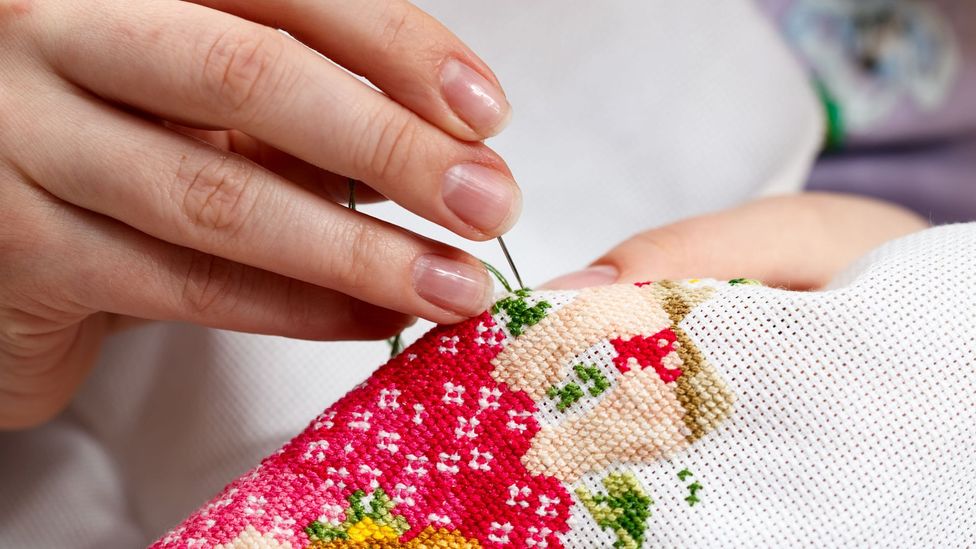In the exhibition Unravel: The Power and Politics of Textiles in Art at London's Barbican, artist LJ Roberts displays three small textile artworks depicting queer parades and protests. The works, part of Roberts's series Carry You With Me: Ten Years of Portraits, are caught between panes of glass so that visitors can see the back of each embroidery, with knots and incidental threads on show. "Working in textiles mirrors the flexibility and resilience that often permeates queer and trans survival and thriving," writes the artist on their website. "The embroideries demonstrate that art centering kinship, persistence, and connection can be made anywhere at any time."
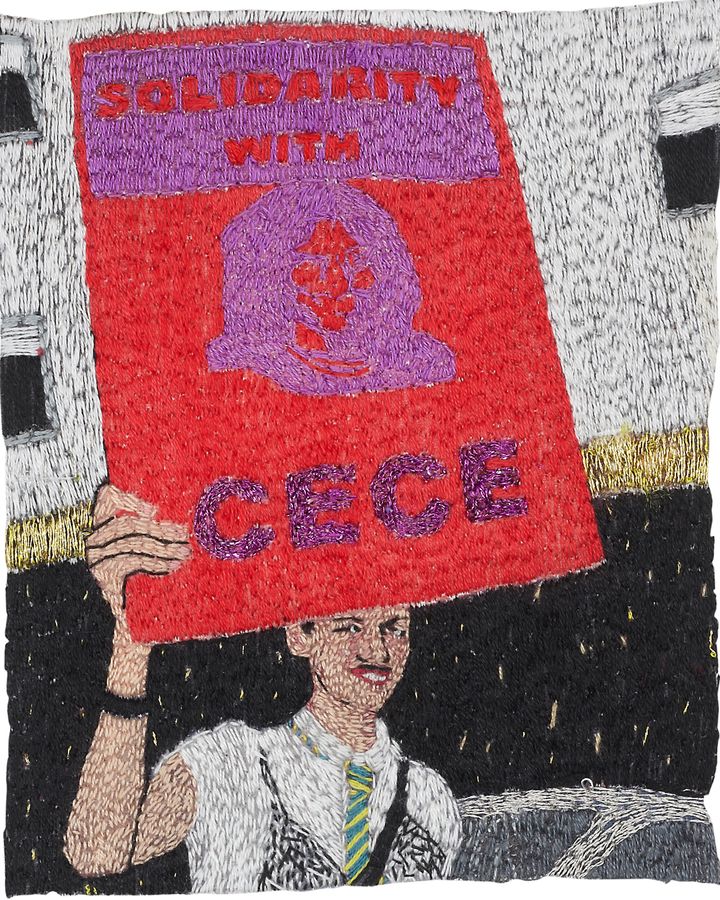
LJ Roberts' embroidery Jacqueline Mautner (Free CeCe) (2012) is displayed at the exhibition Unravel (Credit: LJ Roberts/ Courtesy the artist and Hales Gallery)
It's a long way from the days in which delicate-looking ladies in crinoline sat by the fire, sadly embroidering handkerchiefs because there was nothing else to do. Unravel demonstrates that the interest in craft, already strong, continues to gain traction. And not just in museums but in workshops, women's circles and, of course, in luxury fashion. One of the most delightful examples this spring is Loewe's collaboration with Kyoto-based ceramic studio Suna Fujita. Imagining a world in which humans, animals and nature co-exist as equals, artists Shohei Fujita and Chisato Yamano stitch a delicate menagerie of pandas, penguins, lemurs, otters and boys catching mandrake roots across knitwear and accessories.
It's fun to take something that was mass produced and bring your own personality to that – Tessa Solomons
The resurgence is due, in no small part, to the need to confront the fashion industry's damaging impact – on everything from carbon emissions to planetary boundaries, from animal rights to racial justice. Almost 70% of all clothes are synthetic, while 40% of all clothes produced never even make it to retail; only 2% of garment workers, mainly women, are paid a living wage. The key driver is over-consumption. More and more sustainable fashion activists are calling for the imaginative re-use, through upcycling and repair, of what already exists – and one way to do this is decorative embroidery.
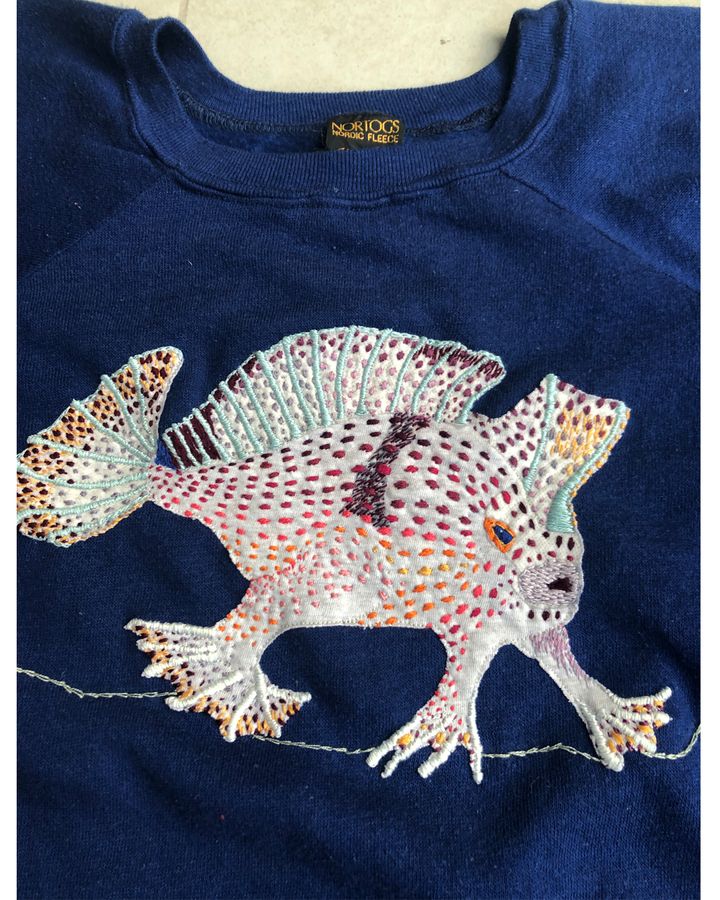
Tessa Solomons' embroidery is inspired by sea creatures and 'the genius of nature' (Credit: Tessa Solomons)
In this, Gen Z are particularly enthusiastic. When @er.embroidery (185.5K followers) embroidered a moon and stars over a mushroom on TikTok, it was viewed nine million times. Repair consultant Tessa Solomons celebrates wear and tear by decorating small holes and stains. "[Visible mending and darning] are ways of showing that you've got a connection with your clothes," she tells the BBC. "You're stepping outside consumer culture, and identifying yourself as somebody with a relationship with their clothes and that you're prepared to invest in that ongoing relationship. And it's fun to take something that was mass produced and bring your own personality to that."
Step by step guide
For the novice, choosing a motif to embroider is the first step. Solomons peppers her commissions with tiny characters. Her inspiration? The natural world. "The designs of nature are just amazing; tiny sea creatures that are the most incredible colours, for example," she says. "For me, creating little creatures puts us back in touch with the genius of nature." There is an added element to her designs: "I like things with eyes, looking out at you, because eyes invite people to look back. A lot of my work is created to start conversations about repair, and something that looks a bit unusual can do that."
More like this:
- A 300-year-old Japanese upcycling method
- Why bespoke tailoring is coming back
- Why living retro is perfect for now
Next, choose the item that you want to embroider. For beginners, woven rather than knitted fabrics are easiest. "A woven fabric doesn't have so much stretch," explains Solomons. Sweatshirts, T-shirts and, in particular, denim allow you to work your design without the fabric moving too much. "With embroidery, you're adding weight on to the fabric," says Solomons. "Move on to finer textures when you've had more practice," Chunky knitwear is great. "If it's fine, you have to be delicate. Ironically, high-street knitwear, often made with synthetics, are easier to work with." It's a win-win: customising synthetic knitwear means it's less likely to be thrown into landfill.
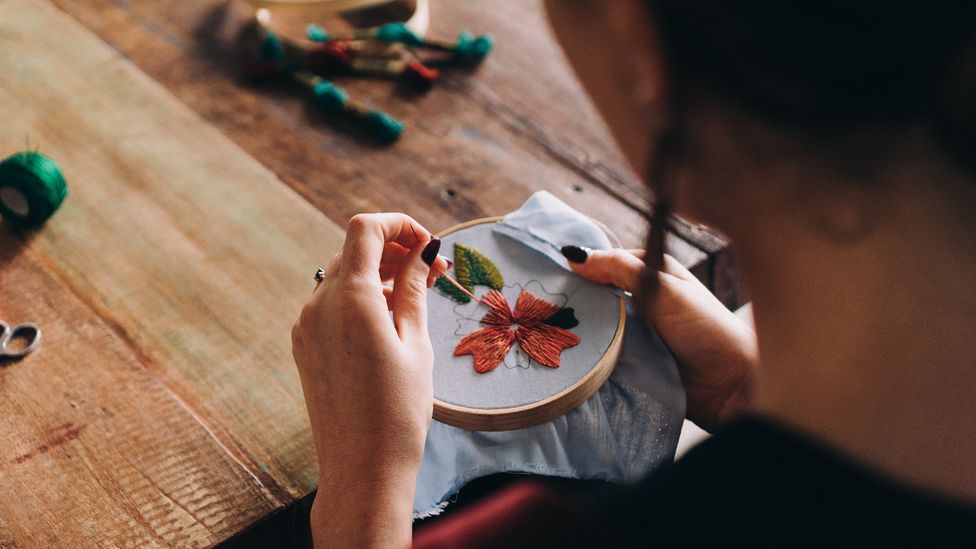
Intricate embroidery has a rich history – and is enjoying a resurgence (Credit: Getty Images)
Get your design on to the paper, by tracing the image on to water-soluble stabilising or backing paper, which can then be stuck on to the fabric and stitched over. Alternatively, draw the design directly on to the fabric with a heat erasable pen. "Do a test inside the hem – to make sure it doesn't leave a mark," says Solomons. Then, place the design at the centre of an embroidery hoop so that the area you're embroidering is kept at the same tension – and away from other parts of the garments, so that you're not sewing sleeves or sides together by accident. Get a proper embroidery needle. Then start stitching, using between one and six strands of any good cotton embroidery thread.
Embroidering tips
- Choose a motif that resonates for you
- Experiment with colour
- Make mistakes - and get playful
- Use your work to start conversations about repair and re-use
How many strands you use depends on the design. "The size of stitches, the colour and the number of strands are your design tools," says Solomons. "The number of strands you use is the equivalent of having different nibs on your pen." In workshops, Solomons shows students how a running stitch looks, using between one and six strands. "For a thicker outline, use four to six strands. For something very delicate or a very fine fabric, use one or two strands. It will help you balance the weight." For a smooth outline to your design, Solomons' preference is the chain stitch but simple back stitch works too. For small areas, use a satin stitch.
For larger areas, alternate long and short stitches till you fill the space. The main thing to consider, however, when working with embroidery threads is "how you finish your threads," says Solomons. "Because you're going to be wearing the garment, you need to make sure the ends of the thread are woven back into the design at the back, so you don't have threads hanging down, which will catch as you pull the garment on and off." Thread care does not stop there. "After you've bought the thread, wind them on to store-bought or homemade bobbins," advises Solomons. "Otherwise, you end up with a box of yarn in a big knot!"
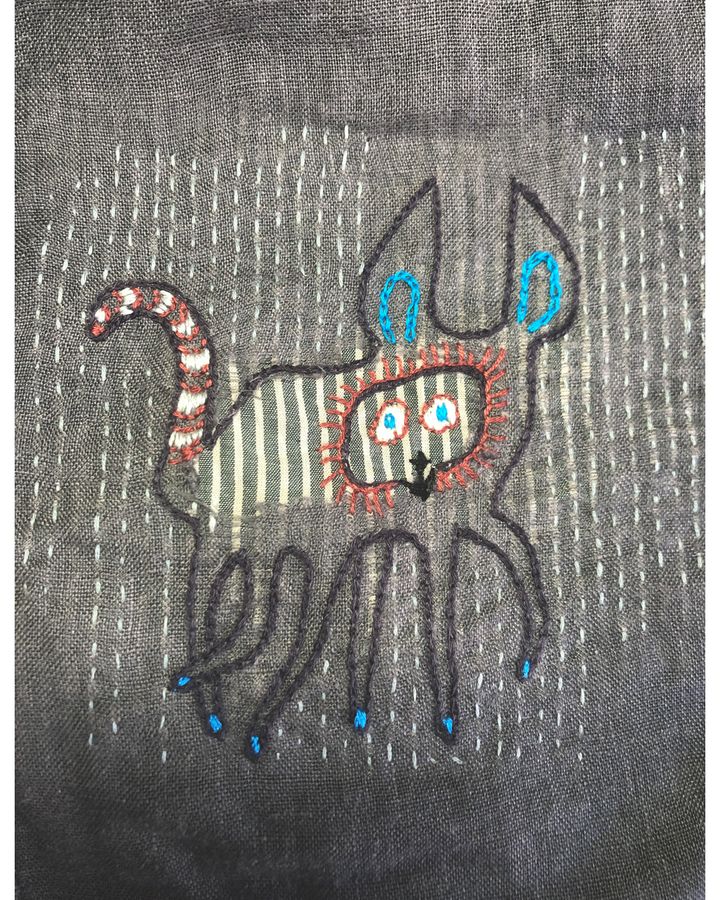
Embroidery is an inventive way to upcycle clothes and give them new life (Credit: Tessa Solomons)
Bobbins, says Solomons, are also good for creating a palette, by laying them down across fabrics and fibres to see what effects different combinations can create. In the meantime, continue to be inspired by the extraordinary work of contemporary embroiderers: Richard Saja, who uses embroidery to turn familiar toile patterns of shepherds and shepherdesses into scenes of whimsy – and mayhem; the moving interplay between text and image of Elaine Reichek; the rendering of popicons, historical figures, and fictional characters into tiny stitched figures by Elsa Hansen. Oldham. Tessa Perlow's nature-based hand embroidery on upcycled materials entrances.
"I always send people to Kate Sekules, and her book, Mend!: A Refashioning Menu and Manifesto. She's very punk – and accessible," says Solomon. "I also love Stewart Easton – and Pascal Monteil, who you’ll find embroidering in a little village outside in Italy." The key seems to be to respond to a passion – and to hold in mind the rich history of the practice. As the curators write in Unravel, "Stitching can be a subversive act: thread can work in a language to challenge fixed ideas and voice free expression."
Unravel: The Power and Politics of Textiles in Art is at the Barbican, London, until 26 May.
--
If you liked this story, sign up for The Essential List newsletter – a handpicked selection of features, videos and can't-miss news delivered to your inbox every Friday.
If you would like to comment on this story or anything else you have seen on BBC Culture, head over to our Facebook page or message us on Twitter.
